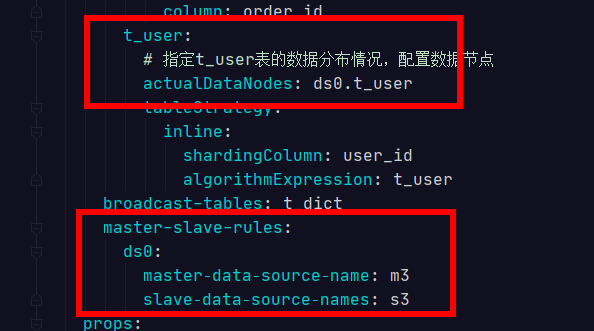ShardingJdbc做读写分离
前面的一篇博客,就写了mysql的读写分离,具体配置如下:
server: port: 56081 servlet: context-path: /sharding-jdbc-simple-demo spring: application: name: sharding-jdbc-simple-demo http: encoding: enabled: true charset: utf-8 force: true main: allow-bean-definition-overriding: true shardingsphere: datasource: #新增一个m2库 names: m2,m3,m1,s3 m1: type: com.alibaba.druid.pool.DruidDataSource driverClassName: com.mysql.jdbc.Driver url: jdbc:mysql://xxxxx:3306/order_db_1?useUnicode=true username: root password: 123456 s3: type: com.alibaba.druid.pool.DruidDataSource driverClassName: com.mysql.jdbc.Driver url: jdbc:mysql://xxxxxx:3306/user_db?useUnicode=true username: root password: 123456 m2: type: com.alibaba.druid.pool.DruidDataSource driverClassName: com.mysql.jdbc.Driver url: jdbc:mysql://xxxxxxx:3306/order_db_2?useUnicode=true username: root password: 123456 m3: type: com.alibaba.druid.pool.DruidDataSource driverClassName: com.mysql.jdbc.Driver url: jdbc:mysql://xxxxxx:3306/user_db?useUnicode=true username: root password: 123456 sharding: tables: t_order: # 分库策略,以user_id为分片键,分片策略为user_id % 2 + 1,user_id为偶数操作m1数据源,否则操作m2。 databaseStrategy: inline: shardingColumn: user_id algorithmExpression: m$->{user_id % 2 + 1} # 指定t_order表的数据分布情况,配置数据节点 actualDataNodes: m$->{1..2}.t_order_$->{1..2} tableStrategy: inline: shardingColumn: order_id algorithmExpression: t_order_$->{order_id % 2 + 1} # 指定t_order表的分片策略,分片策略包括分片键和分片算法 keyGenerator: type: SNOWFLAKE column: order_id t_user: # 指定t_user表的数据分布情况,配置数据节点 actualDataNodes: ds0.t_user tableStrategy: inline: shardingColumn: user_id algorithmExpression: t_user broadcast-tables: t_dict master-slave-rules: ds0: master‐data‐source‐name: m3 slave‐data‐source‐names: s3 props: sql: show: true mybatis: configuration: map-underscore-to-camel-case: true swagger: enable: true logging: level: root: info org.springframework.web: info com.topcheer.dbsharding: debug druid.sql: debug
需要修改2个地方


然后进行插入测试
@Test public void testInsertUser(){ for (int i = 20 ; i<24; i++){ Long id = i + 1L; userDao.insertUser(id,"姓名"+ id ); } }

插入的时候实在主库
@Test public void testSelectUserbyIds(){ List<Long> userIds = new ArrayList<>(); userIds.add(11L); userIds.add(12L); List<Map> users = userDao.selectUserbyIds(userIds); System.out.println(users); }

查询的实在从库。


